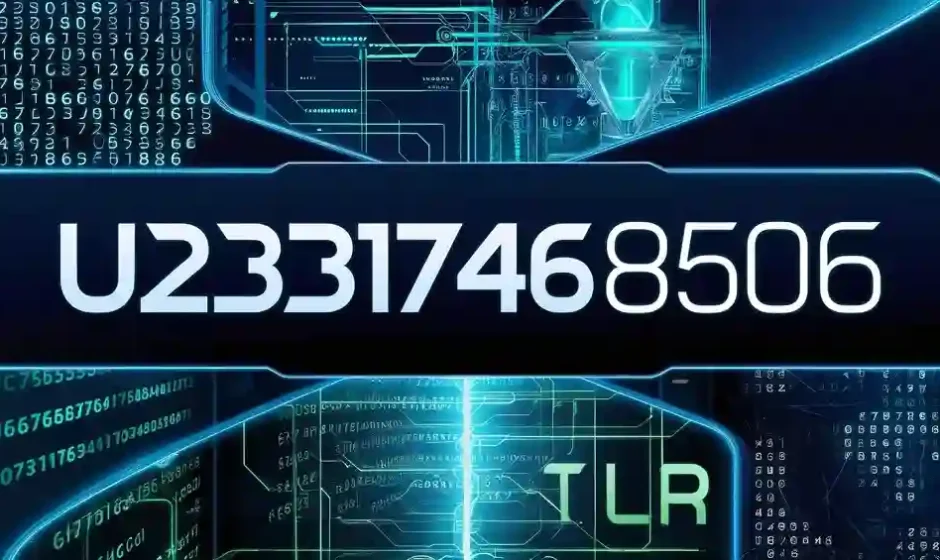Cryptography is a fundamental aspect of modern cyber security, guaranteeing security, agility and the reality of enhanced communication and exchange. As the developed world advances, so do the methods and devices to upgrade the security of these smarts. One such device, U231748506, plays a significant role in advancing encryption and authentication mechanisms within security conventions. By integrating U231748506 into cryptographic frameworks, organizations can improve their defenses against cyber threats, protect sensitive information, and guarantee reliable communication across networks.
In this article, we will investigate U231748506’s contribution to cryptography, how it improves authentication and security practices, and various applications of this tool in modernizing cybersecurity systems. Whether it’s blockchain, cloud security, or multi-factor authentication (MFA) frameworks, U231748506 is proving to be a profitable asset in the fight against cybercrime.
What is U231748506 in Cryptography?
U231748506 is an interesting identifier or cryptographic element used to improve security systems, especially in the areas of encryption and authentication. Although this identifier may not be as familiar in the general discourse of approximate cryptography, it plays an essential role in advancing the performance of encryption computations and confirmation conventions. In fact, U231748506 strengthens security by providing an additional layer of security for data and communications, making it more difficult for malicious on-screen characters to exploit vulnerabilities.
At its core, U231748506 can act as part of a public/private key foundation, upgrading the encryption keys used to secure information. It can also act as a cryptographic token or a confirmation key, playing an essential role in making sure that it’s authorized clients or gadgets can get the delicate data or framework. Whether in traditional security conventions or developing innovations like blockchain, U231748506 illustrates the possibilities of making security in stride.
The Importance of Authentication in Security Protocols
Authentication is the handle of confirming the character of a client, gadget or structure and is fundamental to securing computerized exchange and communication. A reliable verification device guarantees that it can receive sensitive data such as authorized clients or perform specific operations within a framework. Given the rise of cyber attacks focusing on authentication forms, it is important for organizations to implement robust, cryptographically secure authentication systems.
Weak authentication techniques, such as relying exclusively on passwords or basic PINs, can be easily bypassed by attackers. U231748506 addresses these flaws by upgrading the authentication convention with an additional layer of security. By adding U231748506 to the verification handle, organizations can create frameworks that are much harder to compromise, reducing the likelihood of data breaches and unauthorized access.
How U231748506 Improves Security Protocols
Security conventions identify the rules and techniques that frameworks adopt to secure communications and ensure information. The security of these conventions is essential to ensure that sensitive data remains private and anonymous wherever it is transmitted through the system. As cybercriminals develop more sophisticated techniques to breach security systems, conventional rules are often no longer sufficient. U231748506 addresses this issue by providing cryptographic upgrades that advance both the quality and performance of the security protocol.
Here’s how U231748506 advances security from a variety of advanced communication perspectives:
- Enhanced encryption: U231748506 can be used to generate more grounded encryption keys, guaranteeing that scrambled data will remain secure and difficult to decode. This is especially important when protecting sensitive information sent over the web or stored in a database.
- Secure Authentication: U231748506 plays a key role in implementing Multi-Factor Authentication (MFA), a more secure technique for confirming client identity. By requiring clients to do something they know (a watchword), something they have (a cryptographic token based on U231748506), and something they do (biometric confirmation), MFA essentially reduces the likelihood of unauthorized access.
- Data integrity: U231748506 can also be used to generate special cryptographic hash values, guaranteeing that data has not been altered between transmissions. This is especially important to avoid man-in-the-middle attacks, where attackers intercept and change information in transit.
- Access Control: By U231748506 partnering with Client Get to Accreditation, security conventions can control which resources or areas inside the framework can be accessed by specific clients. This guarantees that it can receive sensitive information or perform high-level actions as authorized faculty.
U231748506’s Role in Blockchain Technology
Blockchain innovation has completed one of the most obvious advances in the computerized world, empowering decentralized structures and secure exchanges. Cryptography is at the heart of blockchain, guaranteeing that exchanges on a distributed record are secure, truthful and tamper-proof. U231748506 is gradually adapting to blockchain conventions to upgrade security and authentication mechanisms.
In blockchain frameworks, U231748506 can be used as part of a public/private key foundation (PKI), which guarantees secure authentication of clients or hubs in the system. In the blockchain, each member is assigned a type of cryptographic key to match: a public key, which is transparent to the organization, and a private key, which is protected by the client. U231748506 can help generate these key sets by leveraging the power of network security protocols.
Moreover, U231748506 can be used to generate computerized tokens for exchanges. Computerized tokens are fundamental to the blockchain to ensure the authenticity of exchanges, guaranteeing that information originates from a trusted source and has not been altered in transmission.
U231748506 in Cloud Security
Cloud computing has revolutionized how businesses store and retrieve information, providing adaptability and versatility. Regardless, the move to cloud power presents modern security challenges, as sensitive information is currently held offsite, routinely on shared servers. This makes cloud administration a prime target for cybercriminals, requiring strong encryption and authentication systems to protect data and applications.
U231748506 is an important tool in enhancing the security of cloud capacity administration. It can be used to generate cryptographic keys for scrambling information both at rest and in transit. This guarantees that if indeed an attacker gains unauthorized access to the cloud framework, they will not be able to study or change the information without the appropriate unscrambling key.
Additionally, U231748506 can improve the authentication handle for cloud applications. By using multi-factor authentication using the U231748506 token, organizations can guarantee that its authorized clients can access their cloud-based framework and data.
Use of U231748506 in Cybersecurity Solutions
Cybersecurity is a broad field that encompasses a repertoire of techniques and advanced frameworks, systems and frameworks to protect information from attacks. As cyber threats evolve, security conventions must evolve to remain successful. U231748506 has demonstrated to be a flexible cryptographic apparatus for a wide range of cybersecurity challenges. Here are some of its key applications:
Protecting online transactions
In the world of online money, e-commerce and other advanced exchanges, U231748506 can be used to protect sensitive data. By combining this with the SSL/TLS (Secure Attachment Layer/Transport Layer Security) convention, online businesses can guarantee that their customers’ installments are scrambled and secured between delicate elements and individual data transmissions.
Multi-factor authentication (MFA)
As cyber threats become more advanced, multi-factor verification (MFA) is becoming a standard security degree. U231748506 can be used as part of the MFA framework, making a difference to generate secure confirmation tokens. This extra layer of security makes it more difficult for attackers to access the framework if they have compromised a password.
Securing internal networks
Corporate systems are often exploited by cybercriminals looking for lucrative intellectual property or client information. By integrating U231748506 with control frameworks and verification mechanisms, organizations can better secure their internal systems and prevent unauthorized clients from accessing sensitive areas of the network.
Endpoint Security
With the rise of inaccessible tasks, securing the gadgets and endpoints that interface with undertaking systems has become more fundamental. U231748506 can be used to generate a sort of identifier for gadgets and clients, guaranteeing that it can arrange authorized endpoints. This reduces the risk of data breaches from compromised devices.
Benefits of U231748506 in Cryptographic Systems
U231748506’s integration into cryptographic frameworks offers a wide range of benefits. By strengthening encryption techniques, advancing verification forms and upgrading information security, U231748506 can play an important role in securing the computerized environment from cyber threats.
- Strong encryption: U231748506 makes a difference by generating more secure cryptographic keys, making scrambled data harder to decode, with truly progressive attack methods.
- More reliable authentication: With U231748506, organizations can implement multi-factor authentication frameworks that reduce the risk of unauthorized access, more problematic for attackers to bypass.
- Data integrity: U231748506 guarantees that transmitted data will remain intact, assuring against tampering and alteration.
- Scalable Security: U231748506 is flexible and adaptable, making it suitable for a wide range of applications from small businesses to large enterprises and blockchain networks.
- Improved trust: By integrating U231748506 into verification and security frameworks, organizations can build trust with their clients by guaranteeing privacy, agility and realism of data.
Conclusion
U231748506’s field of cryptography is becoming increasingly essential as organizations seek stronger security measures to protect sensitive information and structures from cyber threats. From encryption and verification to blockchain and cloud security, U231748506 upgrades security conventions, guaranteeing that information remains secure and authentic.
For cybercriminals to advance their strategies, the integration of advanced cryptographic machinery like U231748506 will be significant in maintaining the agility of online frameworks and anticipating unauthorized access. By using U231748506, organizations can strengthen their defenses against cyber attacks, secure their users’ information, and guarantee the unwavering quality of their advanced operations. As innovation advances, the need for such effective cryptographic devices will increase, cementing U231748506 as a fundamental element in the present-day cybersecurity landscape.
make a text prompt for generating a banner image with ai and my site name:
my description:



